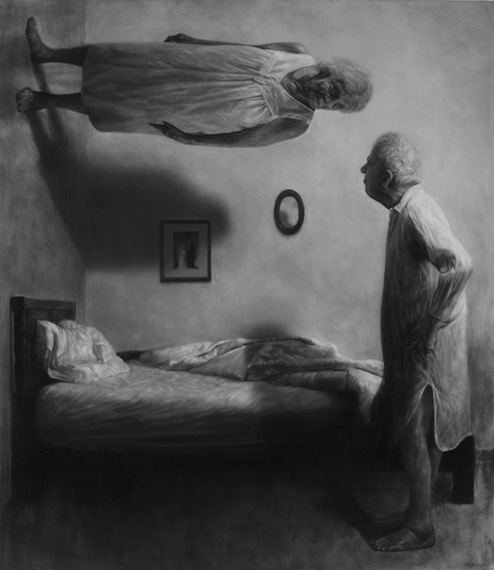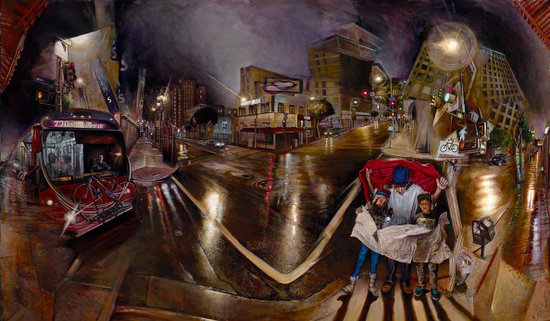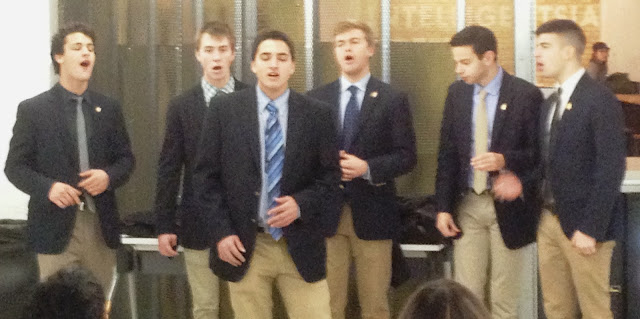 Artist Brenda Goodman in front of her painting Not a Leg to Stand On
Photo: David Hornung
Artist Brenda Goodman in front of her painting Not a Leg to Stand On
Photo: David Hornung
So, just what makes a painting memorable? I guess if I knew I would be painting some memorable paintings myself but as a writer/blogger who rarely paints any more I have done my best to sort through the many submissions that have landed in my e-mail box in the past few weeks and single out some paintings that I think have real staying power and memorability. One way I chose these paintings was to look at a number of them before bed and then see which ones I remembered in the morning. A simple method, I know -- but it works.
Eight of the artists chosen are new to me and their work has never before appeared in my blog. Eight are North American, but I am pleased to include Susannah Martin (Germany) and Martin Llamedo (Argentina) to add some international flavor. Five of the artists are women and five are men: I didn't plan that, it just worked out that way.
It also appears that I tend to favor mature artists who have been working hard for a long time. I really like what writer Malcom Gladwell says about effort as I think it applies very well to art-making:
If you work hard enough and assert yourself, and use your mind and imagination, you can shape the world to your desires.
When I interviewed him in July, the artist Bo Bartlett told me that
"To be earnest is the greatest taboo in contemporary art." I must have very taboo taste, because I have found myself attracted to very earnest paintings. I'm into sincerity, meaning, skill and catharsis and I apparently am leaning towards representation, which looks fresher and fresher to me each day. This is a sincere and large-hearted group of paintings that has a lot to say about the human situation. The human figure remains hugely compelling to me as it will always carry such a variety of meanings with infinite flexibility. Female figures seem to dominate this year's selection.
With each of the paintings below I am including some remarks by its creator to help support the visual elements. Of course, words are always second best: With or without the comments I have provided, these paintings make powerful visual statements on their own. These are great paintings, and all of them are fresh off the easel. They give me hope for the future of painting.

Jason Bard Yarmosky, Sleepwalking, oil on canvas, 83 x 73 inches
JY: The idea of this painting is that my grandfather wakes up in the night to find my grandmother sleepwalking on the wall. The concept of them being on separate planes is a metaphor.
Her shadow, which is behind her, represents the past and is cast over their wedding picture on the wall. This signifies the time gap between when they met and now. Beside the shadow is an oval mirror. The mirror reflects my shadow on the wall opposite of my grandparents, which turns this piece into a self portrait in a way: I am there watching them.
www.jasonyarmosky.com

Mark Dutcher, Meaningful Life, oil and tinted gesso on canvas, 54 1/2 x 43 inches
MD: The painting Meaningful Life is about losing my older sister this last year. I have had an ongoing interest in memory and memorial: in how we remember events and people and how paintings are like monuments that way, that they contain something transferred by the artist into the object. I know it is a pretty old fashioned notion but when I sit in front of a Rothko I can feel the presence of the artist: I can feel something emanating from the painting.
So, I painted five paintings for my sister Laurie, sometimes just incorporating the letters from her name, sometimes using words and fragments from songs. Sometimes the worddeath appears and then disappears. The paintings then became a meditation not so much on loss but on "LIFE" about how beautiful and fragile this all is..
www.markdutcher.com
 Ann Gale, Peter Turning, oil on masonite, 14 x 11 inches
Photo by: Richard Nichols
Ann Gale, Peter Turning, oil on masonite, 14 x 11 inches
Photo by: Richard Nichols
AG: I work from observation, over extended periods, accumulating marks of color, trying to document the sensations flesh, light and space. In Peter Turning, I focused on the fragile and momentary nature of Peter's gesture.
Ann Gale on Tumblr

Martin Llamedo, Tea, oil on linen, 120 x 85 cm.
MLL: The ritual of drinking tea is universal and historical, and that is why I chose it as my subject. Although the act of preparing and drinking tea might appear ordinary or banal -- especially in Western culture -- in some situations and cultures it carries enormous depth and meaning.
In the painting Tea an illusory female figure pours tea over a European style tea table. Frivolity and irony are manifested in the way that the ritual has been modified to include the image of a woman preparing tea on herself. This table -- set for tea -- with its fabric elements, forms the woman's bed covered by sheets that envelop her. Her clothes are like centerpieces (woven lacework) demonstrating that this ritual is deeply embedded in her.
Sitting down to tea often mean time spent communicating with others: hence the four cups. But in this work one sees an illusory figure incarnated for just a moment, perhaps a memory that is about to be lost. Dressed in memories perhaps the figure is prepared to accept her destiny: her eyes, hands and body tell us about this. However, we also discern another person who completes this moment, and that person is herself, with her face hidden outside the painting, perhaps deceiving herself.
This single act of drinking tea manifests a simple truth: that we have just ourselves in life.
http://www.srbrennengalleries.com/Artist-Detail.cfm?ArtistsID=349

Timothy Robert Smith, Revised Maps of the Present (aka: 7th and Main)
oil on canvas, 60 x 108 inches
TRS: This is one of my first multi-dimensional paintings that study the difference between personal and collective experience. Three kids are looking at a wrinkled map, in a world where the rules of time and space wrinkle. Angles intersect, becoming more disjointed towards the outer regions of the canvas, creating kaleidoscopic landscapes that pull viewers into the vortex. They appear to be lost, but without fear; like explorers of dimensions beyond what we accept as physical reality.
Timothy Robert Smith

Susanah Martin, Gorge, oil on canvas, 130 x 130 cm.
SM: A few years ago I turned my attention toward contemporizing a very classical subject in art: the bather. While an 18th or even 19th century painting of a bather could still be accepted as representing a realistic situation, the absurdity of the 21st century bather fascinated me. For me this shift in attitude toward the figure in landscape, points to a much larger and more disturbing anthropological crisis: namely our extreme estrangement from nature.
With these nudes I am attempting both to challenge the traditional role of the nude in art, that is to provide an aesthetically pleasing object of visual/sexual consumption, and to poke a finger in the open wound of our current human displacement. So doing, I hope to trigger contemplation on the causes and effects of the treasonous abuse and subsequent loss of our eco-system home.
Gorge is a particularly confrontational representation of man in nature. The painting focuses on the existential experience of a young woman at the moment of enlightened awareness of her unity with the life force. This is an experience which I provoke with my models outdoors and which I attempt to record or describe in my work.
www.susannahmartin.de

Jeremy Lipking, Sophie at Dusk, oil on linen, 24 x 16 inches
JL: This might sound like a weird answer to some people but I usually don't have a message I'm trying to communicate through my art. I usually do a painting just for the joy of creating.
- Jeremy Lipking, quoted in The Art of the Portrait, The Journal of the Portrait Society of America (volume XI, Issue 46)
www.lipking.com

Nadine Robbins, Mrs. McDonald, oil on linen board, 18 x 24 inches
Text by by Nadine Roberts and Nancy-Jo Hereford
NR & NH: When Plan A goes awry and by design - or default - you resort to Plan B. In letting go, you discover precisely what you wanted to find. Has that happened to you? It did to me and the serendipitous outcome is a new nude: Mrs. McDonald.
Her unexpected evolution happened as I was photographing a model named Kaitlin on a steamy summer day. The warehouse where we were shooting was sweltering. Her flame-colored hair was frizzing wildly and we were both sizzling. Postponing for a cooler day wasn't an option, so I took a run to the local golden arches for more water. On a lark, I ordered a happy meal. I soon learned that Kaitlin, enviously thin, loved her fries. The misery of the heat and humidity evaporated as she savored the salty spuds. And all my preconceived ideas about what I wanted to capture with Kaitlin also evaporated as we went with the moment prompted by an opportune treat.
www.nadinerobbinsart.com

Jennifer Pochinski, The Twelve Year Old, oil on canvas, 48 x 48 inches
JP: This painting came off during one of those losing streaks of painting where nothing good was happening for awhile. Something happened when i went against my instincts to base a painting on Eric Fischl's Bayonne... well just the little girl in white skirt on white background part.
Jennifer Pochinski at John Natsoluas Gallery

Brenda Goodman, Not a Leg to Stand On, oil on wood, 72 x 80 inches
BG: As with so many of my paintings I started with marks all over the surface such as those on top and the right sides. The smaller figure emerged first and the painting just evolved from there.
What was amazing about this painting was that while looking at it when it was done I said: "Wow, this was my childhood." My mother was very dominating and overwhelming and throughout my life I have often felt that if i didn't have a leg to stand on she would devour me (emotionally) and there it was in front of me with only one leg and my mother demanding the whole space. A meaning as strong and clear as that doesn't always reveal itself but it did in this painting, and when that happens it's so fulfilling and significant.
www.brendagoodman.com
































